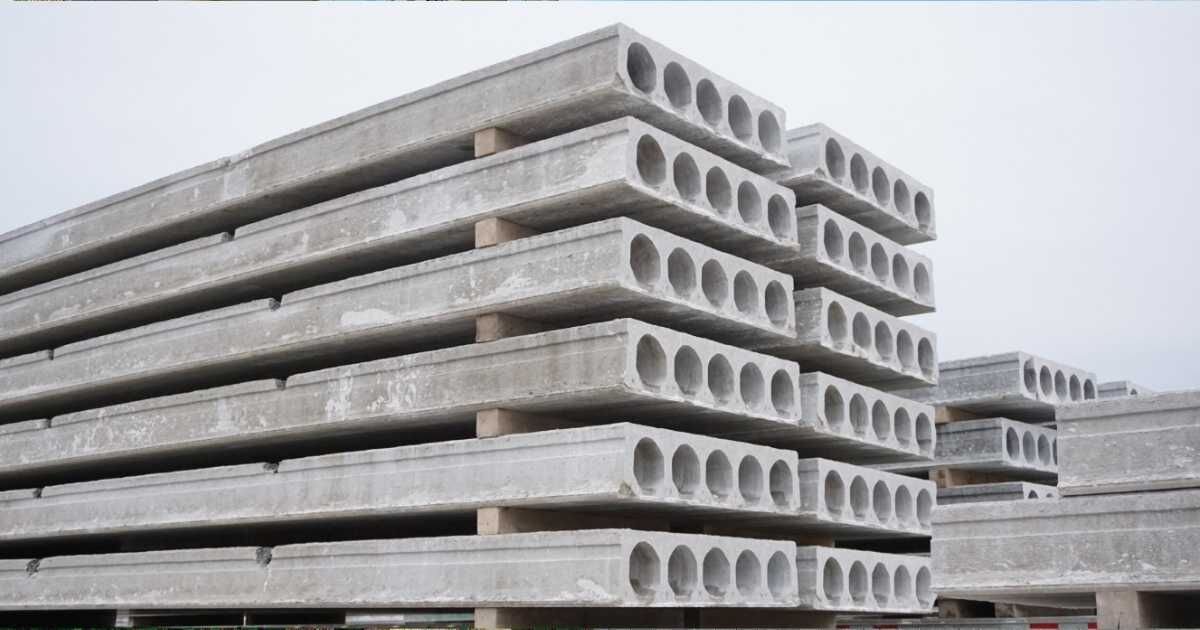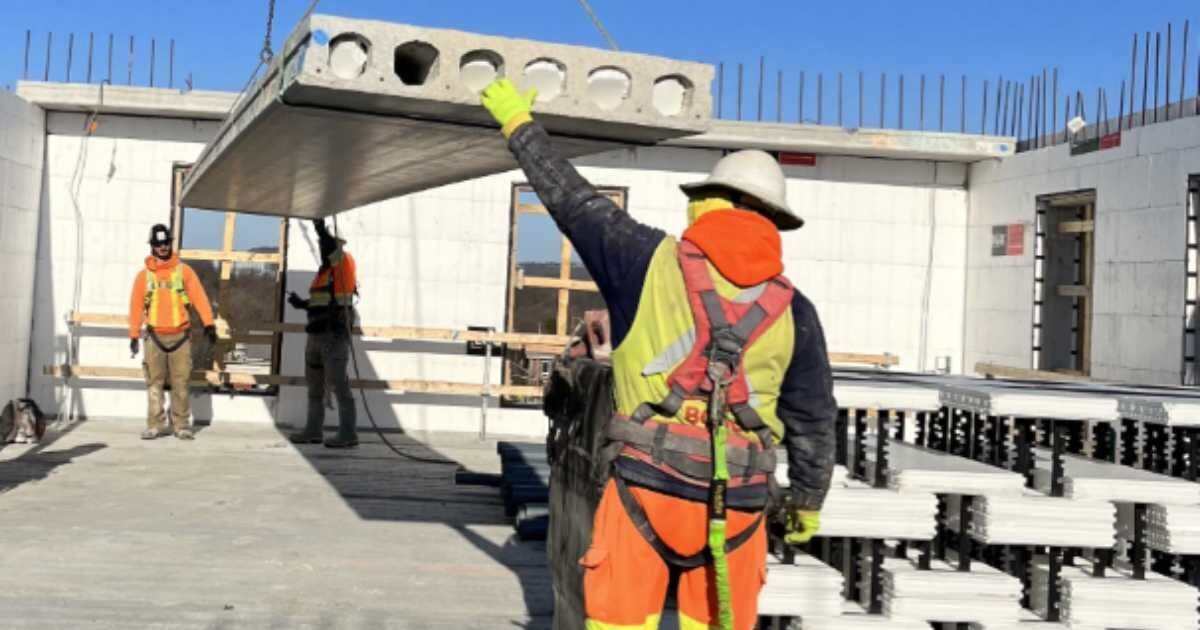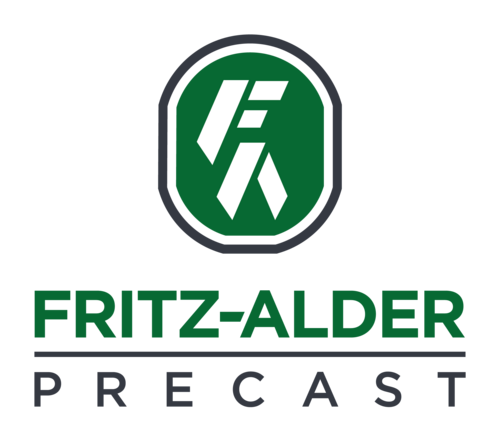
We collect basic website visitor information on this website and store it in cookies. We also utilize Google Analytics to track page view information to assist us in improving our website.

At Fritz-Alder Precast, we’re proud to be leading the way in hollowcore slab manufacturing, with the widest variety of hollowcore sizes and spans you'll find anywhere.
But we're not stopping there. We're always looking for ways to make our slabs even better.
In this blog post, we talk about technologies that are changing the way we make hollowcore slabs and how these advancements are making construction faster, greener, and more efficient.
Hollowcore precast slabs have been around since the early 1900s, gaining popularity towards the second half of the 20th century. They were born out of a simple idea: how can we make concrete slabs lighter and less expensive without making them weaker?
The solution was creating hollow spaces inside the slabs to significantly reduce the amount of concrete needed, making the slabs lighter and easier to handle. This also meant less strain on the building's structure and lower transportation costs.
Hollowcore slabs also offered:
Smaller structural load: Lighter slabs meant less stress on the building's foundation and supporting structures.
Better insulation: Those air pockets acted like tiny insulators, helping to keep buildings warmer in the winter and cooler in the summer.
Faster construction: With lighter slabs, installation became quicker and easier, saving time and money.
And let's not forget about speed. Hollowcore slabs are precast in a factory, which means they're ready to go as soon as they arrive on site. This can significantly speed up construction time, saving everyone time and money.
It's no wonder that hollowcore slabs quickly caught on and became a popular choice for all sorts of buildings, from homes and offices to schools and hospitals. And as technology has advanced, so too has the production of hollowcore slabs, leading to even more impressive benefits - but we'll get to that later.
As with any innovation, the production of hollowcore slabs has evolved significantly since its beginnings some hundred plus years ago.
Modern “wet casting” began as early as 1906. This involved pouring a wet concrete mixture into a mold that already had the hollow spaces incorporated. The concrete would then cure within the mold, taking on the desired shape.
Another early technique, "slip forming," was patented in 1933. This method utilized a machine that continuously extruded concrete into a moving mold, creating a long, uninterrupted slab with pre-formed hollow cores.
Later in the 1960s, the "vibratory extrusion process" emerged. This technique involved using a machine equipped with auger screws to push concrete into a mold. Simultaneously, the machine would vibrate at a high frequency, compacting the concrete and ensuring a dense and uniform structure.
These early methods were pioneering, but they had their limitations. Quality control could be challenging, with inconsistencies in the finished product. Plus, the vibratory extrusion process generated significant noise pollution, and the machinery required frequent maintenance, leading to downtime.
Despite these challenges, these early production methods played a vital role in establishing hollowcore slabs as a viable construction material. They laid the foundation for the remarkable advancements we see in modern hollowcore production today.
Early hollowcore slabs, while innovative, relied primarily on conventional steel reinforcement for strength. However, the introduction of prestressing in the 1950s revolutionized their structural capabilities.
Prestressed concrete involves applying a compressive force to the concrete before it's subjected to the loads it will carry in a building. This is typically achieved by embedding high-strength steel tendons within the concrete and then tensioning them, like pulling on a bowstring. Once the concrete hardens, the tensioned tendons exert a continuous compressive force, counteracting the tensile stresses that occur under load.
This ingenious technique significantly improved the performance of hollowcore slabs. It allowed for longer spans between supports, increased their load-bearing capacity, and reduced the likelihood of cracking.
Prestressing makes hollowcore slabs stronger, more efficient, and more durable. This is what really paved the way for a wide variety of hollowcore applications: from residential and commercial buildings to large-span structures like stadiums and parking garages.
Like the introduction of prestressing, shear compaction arrived, in 1984, as another game-changer in hollowcore production.
Shear compaction extruders, like their vibrating counterparts, use auger screws to shape and compact concrete. However, instead of relying solely on vibration, they harness the power of shear forces.
As the augers rotate and push the concrete forward, they also generate a shearing action within the mix. This intense shearing force effectively compacts the concrete, resulting in a denser and more homogenous structure.
Shear compaction offers a range of improvements over vibratory extrusion, including:
Reduced Noise: This creates a better working environment and reduces disruption to surrounding areas.
Enhanced Strength and Durability: The shearing action produces slabs with exceptional strength and durability, capable of withstanding heavy loads and resisting cracking.
Improved Consistency: Shear compaction leads to greater uniformity in the concrete mix, ensuring consistent quality across every slab.
Faster Production: The efficiency of shear compaction can lead to faster production cycles, enabling precasters to meet tight project deadlines.

At Fritz-Alder Precast, we've always embraced innovation. That's why we were the first company in Ontario to adopt shear compaction technology. We recognized its potential to enhance the quality, efficiency, and sustainability of our hollowcore slab production.
One of the key advantages we've found with shear compaction is its ability to prevent differential camber. Camber refers to the slight upward curve intentionally built into slabs to counteract deflection under load. Differential camber occurs when different sections of a slab have varying degrees of curvature, leading to potential installation and structural issues.
Shear compaction's controlled, three-dimensional vibration at a precise frequency ensures a uniform and consistent slab, minimizing the risk of differential camber and delivering a superior product to our clients.
Shear compaction and prestressing represented a major leap forward in hollowcore production. So, where do we go from here?
Today, there are a range of cutting-edge technologies that are improving the way we design, manufacture, and track precast slabs, including digital tools, innovative mixes, and RFID tracking technology. Here’s how they’re making an impact.
One of the biggest developments is the use of 3D modeling and Building Information Modeling (BIM) in precasting. If you're not familiar, think of BIM as a detailed digital blueprint for a building that contains a wealth of information about every single component, including our hollowcore slabs.
3D models and BIM make it easier to visualize and refine designs, ensuring the slabs fit perfectly into the overall structure. We can take the BIM data and use it to generate precise shop drawings.
BIM also helps streamline coordination between the various trades that all play an important role on a construction site. Everyone has access to the same up-to-date information, reducing conflicts and delays. Plus, the precise dimensions and placement of the slabs in the BIM model help ensure a smooth and efficient installation process.
In a nutshell, 3D modeling, and BIM take a lot of the guesswork and phone tag out of construction.
One of the most exciting developments is self-compacting concrete (SCC). It's like the self-parking cars of the concrete world. SCC flows easily into every nook and cranny of the mold, filling it completely without needing any extra vibration or compaction. This not only simplifies the production process but also results in a smoother, more aesthetically pleasing finish on the slabs.
Another innovation is fiber-reinforced concrete (FRC). Think of it like adding tiny steel hairs to the concrete mix. These fibers increase the concrete's tensile strength (its ability to resist pulling forces), making the slabs even more durable and less prone to cracking. This can also mean using less traditional steel reinforcement, which saves on both cost and environmental impact.
They are helping to create hollowcore slabs that are not only stronger and more durable but also more sustainable and easier to produce.
Have you ever wondered how packages get tracked so efficiently as they travel across the globe? Well, a similar technology is now being used to track precast products, including hollowcore slabs.
Radio Frequency Identification (RFID) tags, tiny computer chips that can store and transmit information, can be embedded directly into the slabs during production. These tags contain important information like the slab's production date, the materials used, and any other relevant details.
If there's ever an issue with a slab, the RFID tag can provide valuable information about its production history, making it easier to identify and address any potential problems.
Even years down the line, if a building needs repairs, the RFID tags can tell workers exactly what type of slab they're dealing with, making maintenance and upgrades a whole lot simpler. It brings a new level of transparency and efficiency to the construction process.
Today's prestressed and reinforced hollowcore floor slabs are a far cry from their early predecessors. They are the result of decades of research, development, and tireless innovation.
But the journey isn't over. As we've seen, the production methods are evolving at a faster pace than ever. At Fritz-Alder Precast, we're excited to be part of this ongoing evolution.
Contact us today to learn more about our hollowcore solutions and how we can help you build smarter, faster, and more sustainably.
